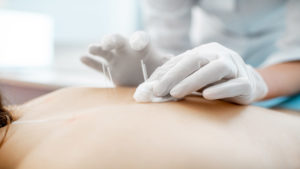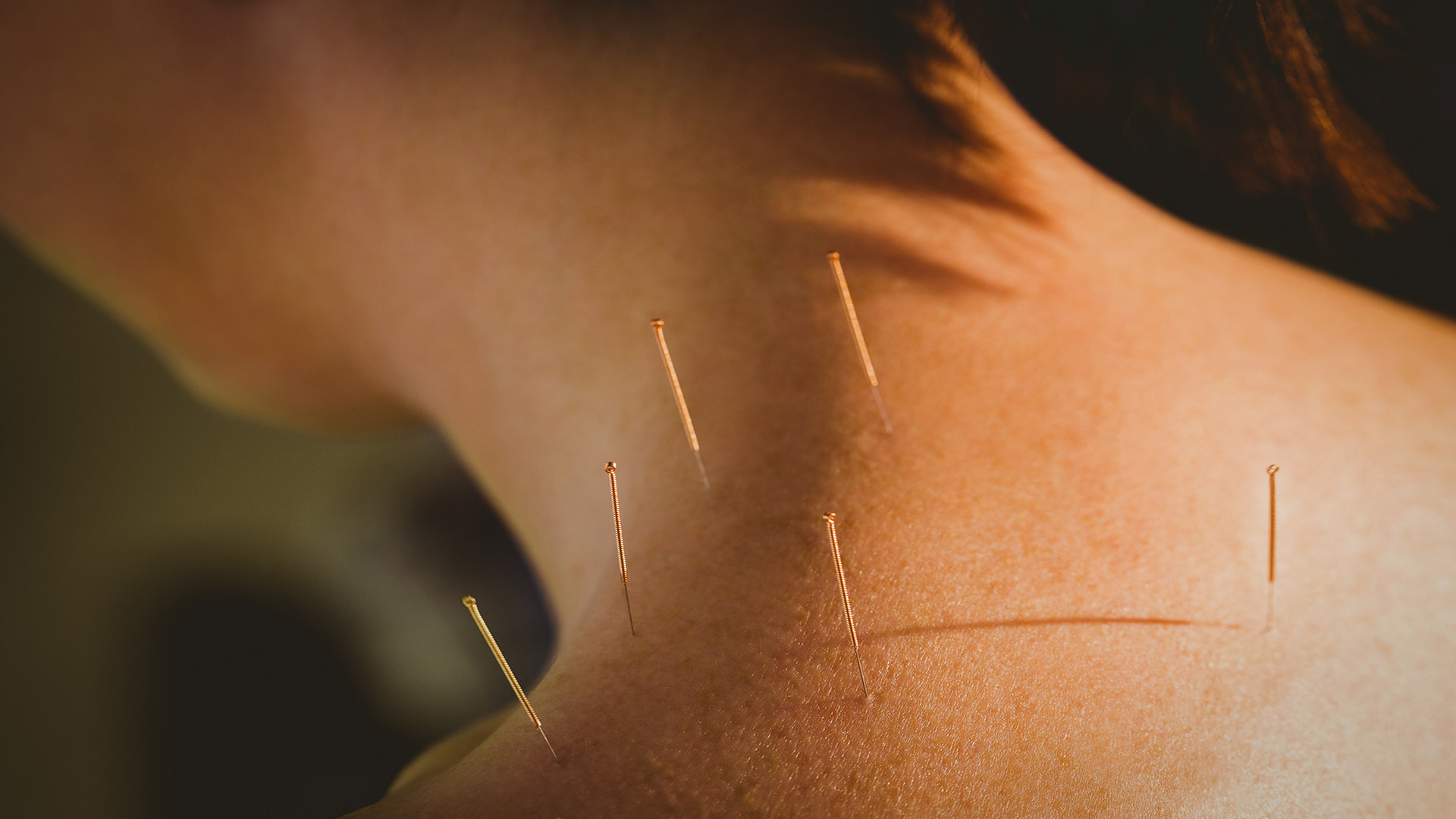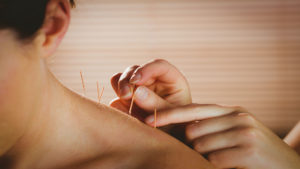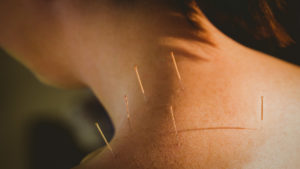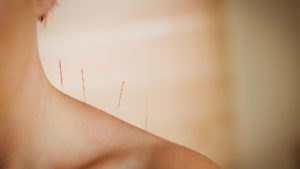Acupuncture offers a natural way to stimulate your body’s natural painkillers. Acupuncture treatment can help with various health and pain issues to provide a pain-free and safe option to deal with health concerns. If conventional treatment options have not worked for you, it’s time to try alternative therapy and find a way to live pain-free.
What is acupuncture?
Acupuncture is an ancient Chinese approach to encouraging your body to heal itself by triggering specific points on the skin with needles. The treatment involves using hair-thin filiform (i.e. not hollow) needles into specific places within the body to address symptoms and the root causes of discomfort, pain, and illness. Many studies have found acupuncture to be effective for various conditions.
According to Traditional Chinese Medicine, very thin needles are inserted into the skin to help balance the flow of energy. This flow of energy, or life force, is referred to as chi, or prana, and connects to all parts of the mind, body and spirit via pathways called meridians within the body. These meridians are analogous to rivers and streams. By placing needles into points along the meridian, the body can increase energy flow to rebalance imbalances. When there is pain or dysfunction within the body it is said that there is a blockage or dam within the river that needs to be unblocked so the flow of energy can be resumed and maintained.
Western practitioners view the procedure as a way to stimulate nerves, muscles, connective tissue, increase blood circulation locally and within the brain, and that it can help stimulate the body’s natural regulatory system to correct internal problems and reduce pain.
Despite the use of needles, the treatment is pain-free and only offers slight discomfort. For those that are a little more needle phobic, there are many non-needle techniques that your acupuncturist can explore with you. One of the most popular uses of acupuncture is to remove pain, including chronic pain without medication. Furthermore, acupuncture has very few risks, complications, or side effects, which makes it a great treatment modality to seek out and see if you can benefit from.
What symptoms and illnesses can acupuncture treat?
Acupuncture practice has been documented to exist for at least 3000 years with some scholars proposing that it has been practiced for around 5000 years. This makes it one of the oldest continuously practiced medicines in the world, next to ayurvedic medicine from India. Over this time, acupuncture has treated much more than just pain. In more modern times, acupuncture has demonstrated efficacy in relieving the discomfort associated with chemotherapy nausea, dental pain, headaches, migraines, labor pain, back pain, neck pain, osteoarthritis, menstrual cramps, allergies, and respiratory disorders, digestive disturbances, stress related conditions, anxiety, depression and mental health concerns, among many other conditions.
For a full list of what acupuncture can treat, consult with an acupuncturist to see if they can assess your symptoms and determine if acupuncture may be an effective treatment for you. Most people use acupuncture to promote natural painkillers such as endorphins to help with acute and chronic pain, such as neck pain, back pain, headaches, migraine, muscle strains and sprains, and joint pain. In addition, many find the treatments reduce inflammation within the body locally at injury or pain site, as well as systemically to improve overall health and well-being.
How was acupuncture discovered?
While the origins of acupuncture theory and practice is lost within the clouds of mysticism and the ancient times, the practice of acupuncture as it is known currently was first written down sometime between 400-200 BCE. Acupuncture was first recorded in the medical text called Huangdi Neijing, or The Yellow Emperor’s Classic of Internal Medicine. It was a dialogue based text written between the Yellow Emperor and his court of acupuncture physicians led by Qibo. Over the millenia, the practice and theory of acupuncture complexified and evolved into a sophisticated and specialized medicine. Acupuncture practice came to the West around the 17th century due to the explorations of and cross-cultural engagements of the Jesuit missionaries. It then came to the forefront of modern western culture when former President Nixon visited China for the first time. One of his assistants had to have an immediate appendix surgery and it was proposed to him to have acupuncture be the sole method for anesthesia and pain relief. This brought acupuncture to the cutting-edge of research on how the body modulates pain. The study of acupuncture’s effectiveness and its proposed mechanisms of action has helped modern medicine to understand the pain regulating systems within the body more than any other technique or condition.
Acupuncture practice in the United States began from humble origins with practitioners practicing out of their homes and offices without an official medical license to offer relief to pain and suffering of all that came to them. This eventually resulted in the arrest and imprisonment of many of the first acupuncturists in the United States. After much protest and public support, acupuncture practice was officially accepted. This began during the 1960’s and continued to evolve and grow during the 1970’s with the first acupuncture school being founded in Boston, Massachusetts in 1975 with other schools in California following shortly after. The National Institutes of Health (NIH) accepted acupuncture as an effective therapy in 1997. Now, more than 40 states have licensing and certification training for those who want to practice acupuncture. Also, the United States now has over 40 accredited acupuncture schools. Acupuncture has became widely known at sought out with patients and clients receiving therapy in a variety of settings such as clinics, hospitals, private practices, and even in spas.
How does acupuncture help?
Although acupuncture is a widely accepted therapy, many doctors and scientists still do not know how acupuncture works and what conditions it may be beneficial for. Some of the tenants of acupuncture theory, including Qi, or Chi, vital life-force, that the ancient Chinese wrote about corresponds to nerve transmission, connective tissue planes, and metabolic components such as oxygen, hormones, neurotransmitters, and nutrients. Additionally, acupuncture affects the functional energy of organ systems by regulating and improving function. Acupuncture seems to support the body’s internal self-regulatory functions assisting the body and mind. The body can release endorphins, natural painkillers and neurotransmitters, such as serotonin, oxytocin, noradrenaline, and dopamine, by stimulating nerve and energy pathways to boost blood flow and brain activity.
Is acupuncture effective immediately?
Everyone experiences acupuncture differently and may have different responses to the therapy. Some people may feel the effects immediately, while others may not feel a difference until after a few sessions. For some, the effects are long-lasting, and for others short-lived, especially when in an acute phase of illness or injury.
However, many people feel a sense of happiness and contentment after a treatment, often in the form of an emotional release. You may feel tired after a treatment which is a sign that your body is working. Some experience changes in eating, sleeping, and bowel habits, while others may not experience change at all.
Definitely rest and allow the treatment to work. Also, increase water intake to help your body stay healthy and work effectively. Most importantly, consult with your acupuncturist about when they anticipate you to start noticing benefits for your particular condition. It is safe to say that if a condition has been chronic for many months or years, that the results may be a little slower to improve in the beginning before picking up momentum and offering effective and meaningful relief.
Is dry needling different from acupuncture?
While both dry needling and acupuncture use the same fine filiform needles, they are a bit different in approach. First, dry needling is a relatively more modern treatment used to ease myofascial pain and dysfunction. Practitioners base their treatments on the assessments of muscle dysfunction and the identification of trigger points within the muscles and tissues instead of the acupuncture meridian systems that connect the entire body and mind. Needles in dry needling are typically retained for only a few minutes, while acupuncture treatments can vary from ten to 30 minutes. Dry needling is an approach that is more in alignment with modern physical medicine. The same techniques used by practitioners who perform dry needling have always been practiced and utilized by acupuncturists. The greater additional benefits of acupuncture practice is that the practitioner will reference the entire myofascial plane, also known as a sinew channel which is the connection of all muscles within a tissue plane, and offer treatment along the distribution of the meridian. An example of this is treating the lower calf muscles of the leg in addition to treating local pain, trigger points and muscle dysfunction within the lower back and hips. This has the added benefit of relieving pain and dysfunction in a more global context and is also seen as treating the root (i.e. cause) of an injury as well as the branch (i.e. symptom) that is presenting. So in short, yes they are different, but an acupuncturist can perform both dry needling to restore dysfunctional myofascial units as well as harmonize the body-mind and correct underlying constitutional conditions that give rise to poor muscle function or pain.
How far do acupuncture needles go in?
For the most part, acupuncture needles are only advanced a few millimeters or ¼ of an inch. If the acupuncturist is attempting to perform a more myofascial trigger point or dry needling therapy technique, then the needles may be advanced a little further in order to target a specific target tissue. The depth would then depend on an individual’s constitution as well the target tissue location, for example the buttocks and glutes would require a deeper insertion compared to muscles of the forearm being treated for tennis elbow. Lastly, the needles are the size of a strand of hair, meaning you will not feel the needles when inserted correctly and at the right depth.
How does acupuncture relieve pain?
There are a few main ways that acupuncture relieves pain. The first is due to its neurophysiological effects. Acupuncture activates nerve receptors at the local site which then get carried along the nerve branch to the dorsal horn of the spinal cord where the pain relievers of endorphins, enkephalins and orphanins are produced and released down the the same nerve pathway and to every part of the body below that specific spinal segment. This effect can be enhanced by applying specific electrical frequencies to the acupuncture points. In addition to the endorphins that are stimulated with these techniques, other neuromodulators and neurotransmitters are released including serotonin, oxytocin, dopamine and noradrenaline, all of which help produce greater feelings of calm, relaxation and well-being. This is usually how practitioners describe the “acupuncture nap” that is so blissful and relaxing. The second way acupuncture relieves pain is through its ability to release myofascial adhesions and trigger points. When an injury occurs in the soft tissue of the body (i.e. muscles, ligaments, tendons) scar tissue can form within the fascia and muscles resulting adhesions, local sticky spots, and myofascial trigger points, hyperirritable points of localized pain due to contracted muscle tissue. Acupuncture changes the tissue state of the fascia and muscles relieving tension, tightness, inflammation and tenderness. The third way acupuncture relieves pain is by increasing the circulation of blood in an area. More blood flow means more nutrients and oxygen can enter into an injured area to help the body heal faster and regenerate new tissues while at the same time removing metabolic waste materials and inflammation.
How often should you have acupuncture?
Like other physical medicine modalities and therapies, acupuncture treatment frequency and duration is dependent upon the reason for consultation. If someone has been in an acute injury then typically more treatments are required for the first week which will usually be around 2-3 visits per week for 2-4 weeks, then after a re-evaluation the treatment frequency may be reduced to 1-2 times per week for 4-6 weeks. Just like physical therapy or chiropractic care, the effects of acupuncture are cumulative, meaning that each treatment builds off of the previous. Even though one will leave feeling calm, relaxed and in less pain after their treatment, the noticeable effects of acupuncture will wear off within 24-48 hours. This will happen until around visit 4-8, at which time the results of acupuncture treatment will begin lasting for more than 3-4 days. Once an individual’s pain is able to be lowered for a longer duration of time from the acupuncture, your treatment frequency will be reduced.
With this said, acupuncture is best utilized as a preventive form of care. It is perfectly fine and even encouraged to receive treatment when one is feeling OK. This way our body’s systems, our well-being and mental disposition can be monitored and maintained in order to remain in our optimal state of being. When the body and mind begin to go out of balance, the effects are usually very subtle and not as obvious. Regular health and wellness maintenance treatments keep the body and mind running as smoothly as possible in order to adjust and fine-tune how it is functioning. This is analogous to regular car engine and drivetrain maintenance. It is easier, and more cost effective, to address a problem when it is very minor compared to replacing an engine or doing major suspension work.
Can acupuncture improve back pain?
Acupuncture is a very effective treatment to improve back pain. Numerous studies have demonstrated that acupuncture provides relief for acute and chronic back pain. As acupuncture stimulates the nervous system and releases natural painkillers, it can definitely provide relief. Additionally, acupuncture releases neurotransmitters and triggers electromagnetic impulses in the body that can lead to a more responsive body ready to combat pain and provide greater feelings of well-being, calm and relaxation. Acupuncture has demonstrated such a high level of effectiveness that it has been recommended as the first line of therapy for individuals suffering from back pain, even before the use of over-the-counter pain medications such as acetaminophen or ibuprofen, due to its effectiveness and low risk of side-effects.
Does insurance cover acupuncture?
Many insurance plans now cover acupuncture because of its effectiveness and low risk of side effects. If your insurance does not cover acupuncture treatments, you may be able to use HSA or FSA to cover the costs. Talk to your employer to find out if your health savings account covers treatment. Recently, Medicare has approved acupuncture treatment for chronic lower back pain that has lasted longer than 3 months. In the State of Oregon, acupuncture treatments may be utilized for individuals involved in a motor vehicle accident or a work-related injury at no cost to the individual. Call your insurance company to see what coverage options they have for acupuncture treatments and approved locations. If you have any additional questions, don’t hesitate to reach out to our office staff and they can help.
Why choose Portland Wellness Care for acupuncture?
Portland Wellness Care is a unique clinic because all of the providers work and collaborate within an integrative model. This means that all of the providers work together to find the best methods and techniques to help our patients get the relief and support they want and need. Additionally, our team specializes in injury treatment, physical rehabilitation, and pain relief. We work with several insurance companies to provide the greatest access to excellent medical care for our patients. Additionally, we have the ability to perform in-house x-ray imaging and diagnostic ultrasound in order to better assess and diagnose musculoskeletal conditions. By incorporating various treatment modalities, we can help you stay well utilizing an integrative approach, including acupuncture, chiropractic care, physiotherapy, massage therapy, and more. Schedule an appointment today and try acupuncture today to see if it’s the right treatment option for you.
Conclusion
Acupuncture offers relief from pain, improves overall well-being, benefits the mind-body-spirit, and alleviates other medical conditions by stimulating the body’s natural healing and self-regulating abilities. If you have difficulty coping with pain or other health problems and conventional methods have not been helpful, acupuncture offers a new and viable option. Schedule an appointment today with Portland Wellness Care and find out if acupuncture can assist you in achieving your health and wellness goals.
